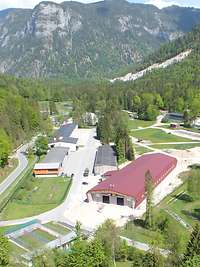
WTDWehrtechnische DienststelleWehrtechnische Dienststelle 52 in Oberjettenberg
WTDWehrtechnische Dienststelle 52 is responsible for matters related to direct and indirect protection and special technologies.


A heavy engine is humming in the distance. A little later, a Dachs AEV dives into the tank wading pit at the Bundeswehr Technical Center for Protective and Special Technologies (WTDWehrtechnische Dienststelle 52) in Oberjettenberg (Bavaria). The humming stops and, against the backdrop of picturesque mountains, the AEV crew start their training.
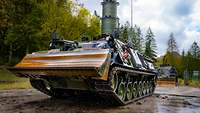
The combat weight of the Dachs AEV is 44 t. The tasks of the armored engineer vehicle include building entry and exit sites at water crossing points or where the banks are steep and muddy.
Bundeswehr, Alexander BielowThe Dachs AEV is the workhorse of the armored engineers. Comprehensive crew training on the equipment is a prerequisite for using the tracked vehicle safely.
A short while ago, the Engineer Training Center in Ingolstadt made use of the WTDWehrtechnische Dienststelle 52 tank wading pit to prepare for a military exercise. They trained crossing the Danube as well as recovery measures and work under water with armored engineer vehicles.
The wading pit offers a variety of training possibilities for man and machine. The pit represents a section of the Elbe Lateral Canal at a scale of 1:1 and has paved routes of entry and exit, which is ideal to practice correct entry into a body of water.
The pit floor is partially paved so that the tank has a safe driving and standing area under water at a defined depth. Another section of the pit is covered in gravel. This is where the crews, also under water, train how to use the dozer blade and the excavator arm.
The tank has a combat weight of 44 t. Thus, every command and every action has to be correct. Not only do the tank crews train how to enter a body of water safely but they also train all the other activities under the watchful eyes of the instructors. Time and again they repeat certain actions until everything has sunk in.
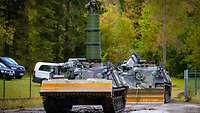
The crew has to carry out radio checks before the training starts. Things only get started if everyone can communicate with one another.
Bundeswehr, Alexander Bielow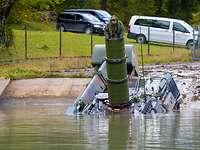
Sergeant Martin Dahten issues commands to slowly let the armored engineer vehicle enter the pit. From his raised position, he has the perfect view of everything that is happening.
Bundeswehr, Alexander BielowNo matter if they are under or above water, communication and close cooperation of the crew are sometimes essential for survival. The crews of several tanks support each other during training. During an actual mission, in particular in a natural body of water with all its imponderabilities, the crew members must be able to rely on each other.
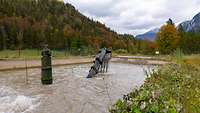
The WTDWehrtechnische Dienststelle 52 tank wading pit represents a section of the Elbe Lateral Canal at a scale of 1:1. A perfect training site for the military engineers and the Dachs AEV.
Bundeswehr, Alexander BielowUnder water, the crews are under considerable mental stress. For the drivers, in particular, there is no visibility and orientation. They have to blindly rely on the tank commanders’ orders and steer the tank according to their instructions.
These routines, colloquially called drill, save lives in case of an emergency. For most of the crew sit packed together like sardines just like in a submarine, several meters under water. Only the commanders stand raised above the water’s surface.
In case of sudden water ingress, the routines to exit a flooded tank, which have been trained in advance, must have sunk in. Nobody must lose their nerves, even if, literally, every second counts. During training, however, the tank remains watertight. Not a single drop enters the crew compartment. When exiting the body of water, the stress level goes down considerably.
The routines are practiced time and again to make sure that the servicemen and -women will exactly know how to work inside and on the tank also in the future. These routines are an ideal preparation for the following mission: crossing the Danube in the subsequent exercise.
Things calm down again at the end of the training week. The picturesque surroundings and the mountains are reflected in the water of the tank wading pit until another Dachs AEV enters the pit.
by Dennis KönigBasic training for the military engineers at the Bundeswehr Technical Center for Protective and Special Technologies (WTDWehrtechnische Dienststelle 52). In Oberjettenberg, the military engineers learn how to handle the Dachs armored engineer vehicle under water. The workhorse of the engineer corps can move up to four meters below the water surface.

The combat weight of the Dachs AEV is 44 t. The tasks of the armored engineer vehicle include building entry and exit sites at water crossing points or where the banks are steep and muddy.
Bundeswehr, Alexander Bielow
The crew has to carry out radio checks before the training starts. Things only get started if everyone can communicate with one another.
Bundeswehr, Alexander Bielow
Sergeant Martin Dahten issues commands to slowly let the armored engineer vehicle enter the pit. From his raised position, he has the perfect view of everything that is happening.
Bundeswehr, Alexander Bielow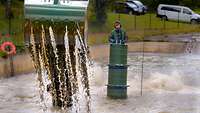
As soon as the Dachs armored engineer vehicle has reached its position, the commander starts the actual exercises. Inside the pit, the gravel is shoveled from one place to another.
Bundeswehr, Alexander Bielow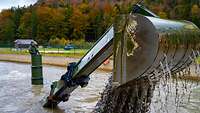
Sergeant Martin Dahten excavates in the wading pit of WTDWehrtechnische Dienststelle 52 in Oberjettenberg
Bundeswehr, Alexander Bielow
The WTDWehrtechnische Dienststelle 52 tank wading pit represents a section of the Elbe Lateral Canal at a scale of 1:1. A perfect training site for the military engineers and the Dachs AEV.
Bundeswehr, Alexander Bielow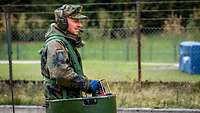
Sergeant Martin Dahten commands far across the water surface and precisely controls the excavator arm.
Bundeswehr, Alexander Bielow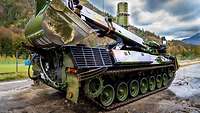
The Dachs armored engineer vehicle is the workhorse of the military engineers. The tank has 830 HP and can be used as an excavator, a bulldozer or a crane.
Bundeswehr, Alexander Bielow
WTDWehrtechnische Dienststelle 52 is responsible for matters related to direct and indirect protection and special technologies.